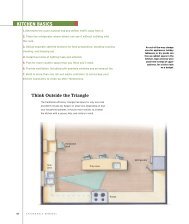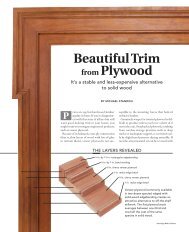Treatments for Problem Windows - Fine Homebuilding
Treatments for Problem Windows - Fine Homebuilding
Treatments for Problem Windows - Fine Homebuilding
Create successful ePaper yourself
Turn your PDF publications into a flip-book with our unique Google optimized e-Paper software.
46 i n s p i r e d h o u s e<br />
<strong>Treatments</strong><br />
<strong>for</strong><strong>Problem</strong><br />
<strong>Windows</strong><br />
These ten solutions will help you deal<br />
with impossible openings<br />
F<br />
or all that windows add to a house—<br />
light, ventilation, and views—they<br />
also invite problems. Breezes become<br />
drafts, sunlight becomes glare, and<br />
pleasant neighborhood landscapes<br />
morph into ominous black holes at night.<br />
The answer is, of course, window treatments.<br />
But the difficulty lies in finding treatments that<br />
enhance rather than detract from these “eyes”<br />
of the home. The question becomes more difficult<br />
when you consider the wide variety of<br />
windows found in homes today.<br />
From among them, I’ve chosen five window<br />
types that commonly present window-dressing<br />
dilemmas: a bank of windows ganged together,<br />
very small windows, patio doors, arched windows,<br />
and bay and bow windows. For each<br />
type, I’ve offered two treatment approaches,<br />
along with professional pointers that will<br />
make the difference between a window<br />
dressing that simply covers up an opening<br />
and one that dramatically enhances it.<br />
Scale and proportion<br />
Scale and proportion are two design principles<br />
that are essential to great-looking<br />
window treatments. Proportion is how the<br />
By DeB Barrett<br />
elements within the window treatment relate<br />
to each other: the valance to the panels; the<br />
swag drop to the cascades. Scale relates the<br />
size of the treatment to the size of the room.<br />
Ask yourself: Is the window in scale to the<br />
room? For instance, small windows look awkward<br />
because they are out of scale with the<br />
room. Window treatments can correct that.<br />
The Rule of Threes refers to the convention<br />
that items grouped together in threes or multiples<br />
of three are visually pleasing. Translate<br />
this to your window treatments by using three<br />
fabrics, three colors, or three components (a<br />
shade, a valance, and panels); by tying back<br />
draperies in the upper third or lower third of<br />
the window; by draping three rather than two<br />
swags over a window. Using three of something<br />
allows you to use one as a statement,<br />
one to contrast, and one to complement.<br />
The Rule of Fifths and Sixths will help you<br />
determine how far a valance should drop. Take<br />
the total height of the treatment (96 inches, <strong>for</strong><br />
example) divide it by 6 (16 inches) and then<br />
by 5 (19 1 ⁄4 inches). The valance drop should<br />
fall between these two measurements.<br />
Deb Barrett is a designer, speaker, and author<br />
on the subject of window treatments.<br />
COPYRIGHT 2008 by The Taunton Press, Inc. Copying and distribution of this article is not permitted.
Design Dilemma<br />
A bank of windows<br />
A row of windows<br />
placed in a series,<br />
often a foot or less<br />
apart, is common<br />
in Georgian-style<br />
suburban architecture.<br />
<strong>Windows</strong><br />
paired side-by-side<br />
are even more common. You can treat each<br />
separately, but with so little space between,<br />
it makes more sense to treat them as if they<br />
were one wide opening, with a single valance<br />
and/or panels at each end. In this case, the<br />
greatest danger is that these windows will<br />
dominate the room, so choose fabrics and<br />
colors that harmonize with the entire space.<br />
Considerations<br />
➤ If your windows take up most of the<br />
wall, let the treatments go corner to<br />
corner. Letting a sliver of wall show at<br />
the ends looks unfinished.<br />
➤ Use a light fabric and simple patterns<br />
and color to give an airy feeling.<br />
➤ If there are more than two windows,<br />
alternating panel colors creates rhythm.<br />
➤ If the unifying valance is very wide, add<br />
a design element (box pleats, scallops, or<br />
dressmaker details) at intervals <strong>for</strong> variety.<br />
solution 2<br />
Punctuate<br />
Here a series of windows<br />
with very little wall space<br />
between has been dressed<br />
with alternating panels<br />
<strong>for</strong> color and woven wood<br />
blinds <strong>for</strong> privacy.<br />
Repeat the same type of<br />
treatment from window to<br />
window. Only one element<br />
(color, pattern, or detail)<br />
should change.<br />
All illustrations: Beverley Bozarth Colgan<br />
solution 1<br />
Unify<br />
the roman shades and valances identify these<br />
windows as two separate openings, but the rod<br />
above and euro-pleated draperies pull them<br />
together as a pair.<br />
Unify the<br />
window by<br />
using identical<br />
shades within<br />
and framing<br />
the opening<br />
with panels.<br />
Shades alone<br />
look unfinished.<br />
Always mount rods above the<br />
window—never on the casing.<br />
Custom drapery rods are usually<br />
placed at least 3 inches above<br />
the casing.<br />
j a n u a r y / f e b r u a r y 2 0 0 6<br />
COPYRIGHT 2008 by The Taunton Press, Inc. Copying and distribution of this article is not permitted.<br />
Rather than<br />
create contrast<br />
with pattern or<br />
color, select a<br />
strong detail<br />
(such as the<br />
Greek key design<br />
here) that runs<br />
through the<br />
composition.<br />
When alternating<br />
colors or<br />
patterns, stick to<br />
two; more than<br />
that is confusing.<br />
You need at least<br />
three windows in<br />
a series <strong>for</strong> this<br />
approach to be<br />
effective.<br />
47
Design Dilemma<br />
Too-small windows<br />
Small windows can<br />
be as difficult to dress<br />
as big, dramatic windows.<br />
But the window<br />
itself is not really the<br />
problem. Most often,<br />
small windows are<br />
awkwardly placed on the wall, falling into<br />
corners or set near the ceiling in a way<br />
that throws off the proportions of a room.<br />
Because of this, when dealing with small<br />
windows, you should first consider the<br />
window’s placement in the room and<br />
think about how a treatment on the window<br />
can bring the room back into balance.<br />
Considerations<br />
➤ Scale your treatment to the window’s<br />
size—fabric, trim, and the overall style<br />
shouldn’t overwhelm it.<br />
➤ Too much contrast and texture on the<br />
window will draw attention to its small<br />
size, so use fabrics that are light in weight<br />
and color.<br />
➤ Does the window need a treatment at<br />
all? Pay attention to the window architecture<br />
and the furnishings; adding to the<br />
casing or shifting furniture might bring<br />
the room back into balance.<br />
solution 2<br />
Work within the window<br />
Deciding how to treat a small<br />
window is all about what<br />
type of mood you’re aiming<br />
<strong>for</strong> in the room. if your look<br />
is clean and simple, you want<br />
to limit your treatment to<br />
match the window’s diminutive<br />
size and scale.<br />
48 i n s p i r e d h o u s e<br />
Patterns should be<br />
small and subtle.<br />
solution 1<br />
Work around the window<br />
use treatments outside the window to<br />
make it look larger or to visually shift<br />
its placement on the wall.<br />
Be sure to use<br />
blackout lining<br />
when “enlarging” a<br />
window, or the light<br />
defining the opening<br />
will give your<br />
illusion away. This is<br />
especially important<br />
if you use a wall-towall<br />
treatment that<br />
obscures where the<br />
window ends and the<br />
wall begins.<br />
Adding a bench or<br />
table below, between<br />
the panels, creates a<br />
vignette that draws<br />
attention to the<br />
window.<br />
Café curtains in a lightweight fabric,<br />
on a small-diameter rod, create a<br />
romantic, cottagey feel. For a more<br />
austere look, go with a simple shade.<br />
Keep projections, like<br />
curtain rods, close to<br />
the window.<br />
Remember the rules of<br />
proportion and scale and<br />
make sure the elements of<br />
the treatment work together<br />
and in the room as a whole.<br />
COPYRIGHT 2008 by The Taunton Press, Inc. Copying and distribution of this article is not permitted.<br />
Mounting the<br />
rod high—even<br />
on the ceiling<br />
—and using<br />
floor-length<br />
panels can<br />
visually enlarge<br />
a small window.
Design Dilemma<br />
Patio doors<br />
frencH Doors sliDing Doors<br />
<strong>Treatments</strong> <strong>for</strong> patio doors are challenging<br />
because they require a design that not<br />
only controls light, drafts, and privacy<br />
but also allows the doors to open and<br />
close without interference. Doors are also<br />
an aesthetic challenge because of their<br />
squarish shape. Since the eye prefers<br />
rectangles to squares, your patio door<br />
will look better if you use your treatments<br />
to extend its height or width.<br />
Considerations<br />
➤ Take traffic patterns and the door swing<br />
into account. Mount top treatments so they<br />
hang no lower than the top door casing.<br />
➤ If you’re mounting treatments on the<br />
door, use similar treatments on the<br />
room’s windows.<br />
➤ Light switches are often on the wall<br />
next to the door; don’t obscure them.<br />
solution 2<br />
Off the door<br />
stacking draperies off to<br />
both sides of the door turns<br />
the monolithic square into a<br />
rectangle with more pleasing<br />
proportions. it’s also the most<br />
practical approach <strong>for</strong> sliders.<br />
When the drapery stack-back<br />
clears the glass completely,<br />
you get maximum light inside<br />
and a cleaner look from the<br />
outside, because no fabric is<br />
hanging in the window.<br />
solution 1<br />
On the door<br />
mounted on the door, a top-down/bottom-up woven<br />
blind doesn’t interfere with opening and closing, and<br />
when opened at the top, it balances light and privacy.<br />
Beware of projections<br />
when<br />
mounting hardware<br />
on the<br />
door, as they can<br />
interfere with<br />
operation.<br />
Blinds and shades<br />
need hold-downs<br />
and clearance <strong>for</strong><br />
levers and handles.<br />
An upholstered<br />
traverse rod<br />
eliminates the<br />
need <strong>for</strong> a valance,<br />
which can interfere<br />
with opening and<br />
closing.<br />
On-the-door solutions are a<br />
good choice when wall space<br />
around the door is limited or<br />
when draperies would cover<br />
wall space intended <strong>for</strong> art,<br />
furniture, or outlets.<br />
A valance<br />
hides the head<br />
rail and cord<br />
lock (cordless<br />
versions are<br />
available, but<br />
you need to be<br />
able to reach<br />
them in the<br />
“up” position).<br />
In the case of sliders, oneway-draw<br />
draperies or vertical<br />
blinds are great choices <strong>for</strong><br />
function, but they can look out<br />
of balance. Use an inoperable<br />
panel on the opposite side to<br />
balance the one-way draw.<br />
j a n u a r y / f e b r u a r y 2 0 0 6<br />
COPYRIGHT 2008 by The Taunton Press, Inc. Copying and distribution of this article is not permitted.<br />
49
Design Dilemma<br />
Arched windows<br />
Arches are dramatic, but<br />
they can be difficult to<br />
dress. The curve requires<br />
custom mounting applications<br />
and treatment<br />
styles. In addition, some<br />
tall arched windows are<br />
trimmed out with decorative<br />
moldings that are<br />
meant to be shown; furthermore, the trim<br />
can create projection and clearance problems<br />
<strong>for</strong> treatments that cover them.<br />
Considerations<br />
➤ First ask, Do I really need to cover the<br />
arch? One choice is to just leave the<br />
window untreated and apply light- and<br />
heat-reflecting window film.<br />
➤ If function is <strong>for</strong>emost, consider hard<br />
treatments made especially <strong>for</strong> arches,<br />
with a standard blind or shade placed<br />
underneath.<br />
➤ Most arches are not completely symmetrical,<br />
so be sure you or your designer<br />
makes a template of the curve be<strong>for</strong>e<br />
ordering or making treatments.<br />
solution 2<br />
Play down<br />
the curve<br />
straight panels hung on rings<br />
from a decorative rod play<br />
down the arch yet still allow<br />
it to be visible when the<br />
drapes are open.<br />
in a high-ceilinged room,<br />
you might mount the rod<br />
across the window at the<br />
bottom of the arch (as long as<br />
light through the arch is not<br />
an issue) to bring the room<br />
height down to scale. in a<br />
room with a standard 8-foot<br />
ceiling, however, this treatment<br />
would be oppressive.<br />
50 i n s p i r e d h o u s e<br />
solution 1<br />
Play up the curve<br />
let the moldings and trim<br />
act as the frame <strong>for</strong> your<br />
window by choosing a simple,<br />
box-pleated arched valance<br />
paired with a shade or blind<br />
to provide light control and<br />
privacy when needed. When<br />
pulled up, it hides behind<br />
the valance.<br />
A shaped hem on the<br />
bottom mimics the<br />
curve of the window.<br />
When mounting<br />
inside the window<br />
frame, choose a<br />
shade with a slim<br />
profile, such as a<br />
roller shade, a singlecell<br />
honeycomb, or a<br />
1-inch mini-blind.<br />
Use lots of fabric.<br />
Custom draperies are<br />
generally 2.5 times<br />
the width of the glass<br />
they cover.<br />
A bold, large-scale<br />
pattern is fine here.<br />
It’s the visual weight<br />
of the draperies that<br />
draws attention away<br />
from the arched<br />
window.<br />
COPYRIGHT 2008 by The Taunton Press, Inc. Copying and distribution of this article is not permitted.<br />
<strong>Fine</strong> details enhance<br />
the overall look<br />
without drawing<br />
attention from the<br />
window itself. In this<br />
example, trim on the<br />
bottom and covered<br />
buttons two-thirds<br />
of the way down the<br />
pleat make the treatment<br />
pop.<br />
Keep fabrics simple:<br />
Muted colors and<br />
tone-on-tone patterns<br />
won’t overpower the<br />
architecture.<br />
Window films are<br />
an effective way<br />
to achieve light<br />
control and privacy,<br />
but they are<br />
best applied by a<br />
professional. Note<br />
that a window<br />
film can change<br />
the appearance of<br />
colors in a room.
Design Dilemma<br />
Bays and bows<br />
Because they protrude from the house,<br />
bay windows and bow windows provide<br />
greater light and visual space to interiors.<br />
But their multiple sections and angles<br />
also make them confusing to treat.<br />
Considerations<br />
➤ The big question is whether to treat<br />
bows and bays as separate windows or<br />
as one. While you can treat each section<br />
separately, it is important that the<br />
window be perceived as a whole. A top<br />
treatment across the entire window or a<br />
repeating pattern are two ways to unify.<br />
➤ Just as arched windows are rarely true,<br />
the angles on bows and bays are rarely<br />
uni<strong>for</strong>m. So make sure angles, widths,<br />
and lengths are measured, and projections<br />
<strong>for</strong> each angle are checked.<br />
solution 2<br />
bay<br />
Following the curve<br />
an alternative, shown<br />
on this bow window,<br />
is to have the primary<br />
treatment follow the<br />
angles of the window.<br />
Here, simple euro-<br />
pleated panels on a<br />
custom-bent decorative<br />
iron rod fill the wall<br />
space between the win-<br />
dows, unifying the design.<br />
solution 1<br />
The window as a stage Mounting panels on the inte-<br />
roman shades in a solid textured fabric give light<br />
rior wall like this treats the<br />
window as a stage and draws<br />
control and privacy to each window individually,<br />
attention to it. This is a good<br />
while patterned panels on a decorative rod unify<br />
strategy if the window seems at<br />
the bay as a whole.<br />
odds in a room, which sometimes<br />
happens when bays are<br />
added in a remodel.<br />
Creating a<br />
window seat,<br />
or nestling a<br />
seating arrangement<br />
within<br />
the arc of the<br />
window adds<br />
coziness and<br />
integrates the<br />
bay into the<br />
room.<br />
Introducing rhythm<br />
through color or<br />
details works <strong>for</strong><br />
bows as well as <strong>for</strong><br />
windows in a series.<br />
Make sure that the<br />
panels are the same<br />
width so they look the<br />
same. This approach<br />
can help camouflage<br />
uneven wall areas,<br />
which are common in<br />
bays or bows.<br />
For more, see<br />
Resources, page 82.<br />
j a n u a r y / f e b r u a r y 2 0 0 6<br />
COPYRIGHT 2008 by The Taunton Press, Inc. Copying and distribution of this article is not permitted.<br />
boW<br />
51

















